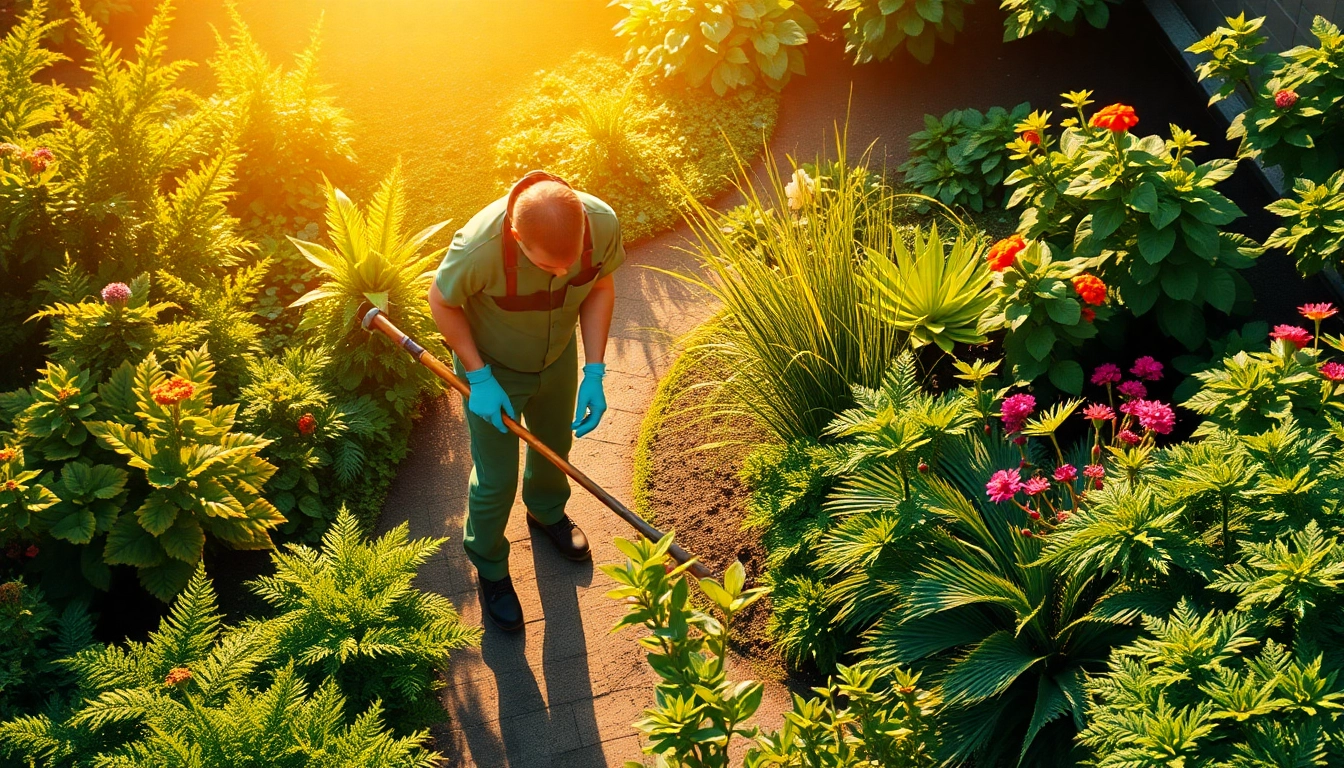Understanding Garden Maintenance Services
What Is a Garden Maintenance Service?
A garden maintenance service encompasses a range of activities aimed at ensuring the health, aesthetics, and functionality of outdoor spaces. These services can be vital for homeowners, commercial properties, and community gardens, offering everything from basic upkeep to specialized horticultural practices. Common offerings include lawn care, pruning, pest management, and soil enhancement, fulfilling the diverse needs of gardens throughout various seasons. Whether you’re looking to hire a professional team or managing a garden yourself, understanding the breadth of maintenance options can significantly enhance your landscape.
The Importance of Regular Maintenance
Regular maintenance of your garden is crucial for several reasons. It not only preserves the beauty and appeal of your landscape but also prevents the onset of larger issues that can arise from neglect. Regularly maintained gardens tend to have healthier plants, improved curb appeal, and can significantly contribute to property value. Moreover, engaging in consistent garden care allows for proactive management of pests and diseases, ensuring that your garden remains vibrant and productive throughout the year. In essence, investing in a reliable garden maintenance service results in a thriving landscape that can be enjoyed by you and your community.
Key Components of Garden Maintenance
The key components of garden maintenance can typically be categorized into several essential practices:
- Lawn Care: This includes mowing, aeration, and fertilization, which promotes healthy grass growth.
- Pruning and Trimming: Regular pruning of flowers and shrubs helps control plant growth and encourages blooming while ensuring plants maintain their shape.
- Weeding: Keeping weeds at bay not only improves your garden’s appearance but also reduces competition for nutrients and water.
- Pest and Disease Management: Monitoring plants for signs of disease and pests is crucial for prevention and treatment.
- Soil Management: Regularly testing and enhancing soil health through amendments fosters a nutrient-rich environment for your plants.
Choosing the Right Garden Maintenance Service
Evaluating Service Providers
Selecting the right garden maintenance service is an important decision that can greatly affect the future of your outdoor space. Start by assessing potential providers based on their experience, reputation, and the range of services they offer. Look for companies that are licensed and insured, as this often indicates professionalism and accountability. Online reviews and testimonials from trusted sources can give you insight into their reliability and quality of work. Furthermore, consider reaching out for referrals from friends or family who have used garden maintenance services in the past.
Questions to Ask Before Hiring
When you have narrowed down your list of potential service providers, it is vital to ask the right questions to ensure they meet your needs:
- What services are included in your maintenance plan?
- Do you offer customizable service packages?
- What is your approach to handling pests and diseases?
- Can you provide references or examples of previous work?
- How do you determine pricing, and are there any additional costs I should be aware of?
These questions will help clarify the provider’s capabilities and ensure they align with your gardening goals.
Comparing Prices and Packages
Once you’ve gathered information from multiple maintenance services, it’s time to compare prices and packages. Look at what each service includes and how frequently they perform each task. While the cheapest option may be tempting, consider the quality of service and the potential hidden costs of inadequate care. Make sure to evaluate the long-term benefits of each package rather than just the upfront costs. It’s often more economical in the long run to invest in comprehensive service that ensures a well-maintained garden.
Common Garden Maintenance Tasks
Seasonal Plant Care and Weeding
Seasonal care is fundamental to maintaining a healthy garden. Spring is the time to give your garden a thorough cleaning, including weeding, mulching, and planting annuals. Summer may require more frequent watering and deadheading of flowers. Fall care focuses on preparing the garden for winter by cutting back perennials and mulching to protect the soil. Knowing the right time to perform these tasks helps ensure your garden thrives year-round, allowing plants to receive the nutrients and attention they require to flourish.
Lawn Maintenance Techniques
Maintaining a healthy lawn involves several key techniques:
- Mowing: Regular mowing promotes healthy growth. Keeping your grass at the recommended height helps shade the soil, reducing weed growth.
- Aeration: Aerating the soil improves water and nutrient circulation, promoting a healthier root system.
- Fertilization: Applying fertilizers at the right time of the year can replenish nutrients in your soil, supporting robust growth.
Integrating these techniques provides a foundation for a lush, green lawn that enhances your garden’s overall aesthetics.
Tips for Soil Health Management
Soil health management is an integral aspect of garden maintenance that often gets overlooked. Healthy soil contributes to the vitality of your plants. Here are some effective strategies:
- Regular Testing: Test your soil annually to understand its nutrient composition and pH level.
- Organic Amendments: Add organic matter like compost to improve soil structure, retain moisture, and increase nutrient availability.
- Cover Cropping: Planting cover crops during off-seasons can protect the soil from erosion and add nutrients back to the soil once tilled under.
Implementing these practices will create a thriving environment for your plants, enabling them to reach their fullest potential.
Advanced Techniques in Garden Maintenance
Implementing Sustainable Practices
With a growing awareness of environmental issues, incorporating sustainable practices into your garden maintenance can have a significant impact. These practices include:
- Water Conservation: Implement drip irrigation systems to minimize water waste and ensure efficient delivery to plants.
- Organic Pest Control: Use natural methods and organic pesticides to manage pests without harming beneficial insects.
- Native Plant Selection: Choosing native plants can reduce water and maintenance needs while supporting local wildlife.
Emphasizing sustainability not only preserves the environment but also creates a more resilient garden.
Utilizing Technology in Garden Care
The integration of technology into garden maintenance has revolutionized how we care for our outdoor spaces. Innovations include:
- Smart Irrigation Systems: These systems can monitor weather conditions and soil moisture levels to optimize watering schedules.
- Garden Management Apps: Many applications help track plant growth, schedule maintenance tasks, and even diagnose plant diseases through image recognition.
- Drones for Monitoring: Drones can provide aerial views of large properties, offering insights into areas that require attention.
Employing technology in garden care can streamline processes and yield faster, healthier results.
Designing Aesthetic Landscapes
A well-maintained garden is often characterized by its aesthetic appeal. Landscape design principles should be considered in garden maintenance, including:
- Color Theory: Understanding how colors work together can help create visual harmony in plant selection.
- Texture Variations: Mixing plants with different textures can add depth and interest to your garden beds.
- Structural Elements: Incorporate pathways, trellises, and decorative features that draw the eye and guide visitors through your space.
By applying these design principles, you can enhance your garden’s visual appeal, creating a space that is both beautiful and functional.
Measuring Success in Garden Maintenance
Tracking Health and Growth Metrics
To determine the effectiveness of your garden maintenance efforts, tracking health and growth metrics is essential. Key performance indicators might include:
- Plant growth rates and health indicators like leaf color, vigor, and bloom frequency.
- Soil health measurements, including pH balance and nutrient levels.
- Pollinator activity and biodiversity assessments that indicate ecosystem health.
Regularly monitoring these metrics allows you to assess where your garden thrives and where improvements are needed.
Customer Feedback and Adjustments
For those using a garden maintenance service, soliciting feedback from the service provider can yield substantial insights. Establishing a communication channel for feedback ensures that services provided align with your expectations and needs. It’s beneficial to establish a timeline and criteria for review to facilitate meaningful adjustments and ensure continued satisfaction with the maintenance being performed.
Long-term Goals for Landscape Care
Finally, establishing long-term goals for your garden can provide direction and purpose to your maintenance efforts. Goals might include:
- Achieving and maintaining specific health metrics for your plants.
- Improving soil health over time for optimal growth conditions.
- Enhancing the biodiversity of your garden ecosystem through intentional planting.
By setting measurable long-term goals and consistently working towards them, you ensure that your garden can continue to flourish and provide enjoyment for years to come.




